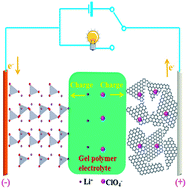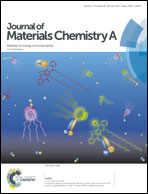A quasi-solid-state Li-ion capacitor with high energy density based on Li3VO4/carbon nanofibers and electrochemically-exfoliated graphene sheets†
Abstract
Electrochemical capacitors are playing increasing roles in our daily life but their low energy densities limit their wide applications. The appearance of Li-ion capacitors (LICs) is regarded as the beginning of a new era of increased energy densities in the field of electrochemical capacitors. However, it is a great challenge to find a suitable anode material with superior electrochemical performance. In addition, the intrinsic instability of the liquid electrolytes used in LICs can easily result in leakage of the electrolyte and causes a serious safety issue. Here, a quasi-solid-state LIC is fabricated by applying Li3VO4/carbon nanofibers as the anode and electrochemically-exfoliated graphene sheets as the cathode in a gel polymer electrolyte. It achieves an energy density of 110 W h kg−1 and a good cycling performance. Our results demonstrate that quasi-solid-state LICs provide a key system acting as a bridge between conventional Li-ion batteries and supercapacitors, while meeting the high safety demands of electronic devices.



 Please wait while we load your content...
Please wait while we load your content...